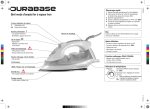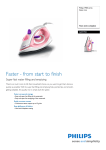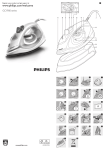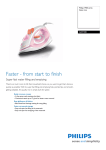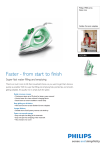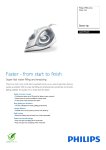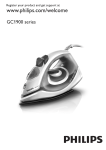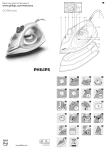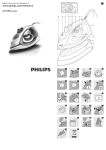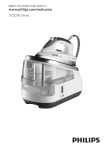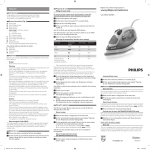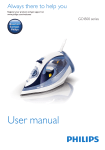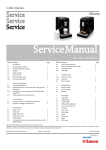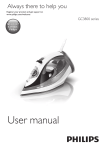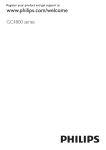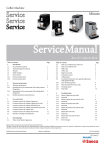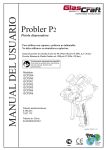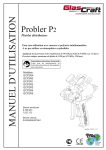Download GC1900 series
Transcript
GC1900 series 1 A B C D E F G H I J 2 3 4 5 6 7 8 9 10 11 12 13 14 15 16 17 K L M N 1 O 18 19 22 23 20 2 21 English Introduction Congratulations on your purchase and welcome to Philips! To fully benefit from the support that Philips offers, register your product at www.philips.com/welcome. A B C ----D E F G H I J K L M N O General description (Fig. 1) Spray nozzle (all types except GC1903/GC1910) Cap of filling opening Steam control O= no steam small cloud = minimum steam large cloud = maximum steam x = Calc-clean position Spray button 8 (all types except GC1903/GC1910) Steam boost button \ (all types except GC1903/GC1905/GC1910/GC1920) Automatic shut-off light (GC1990/GC1991 only) Temperature dial Double-Active Calc System (all types except GC1903/GC1905/GC1910/ GC1920) Temperature light Mains cord Type plate Water tank MAX water level indication Soleplate Heat-resistant storage cover (GC1981/1991 only) Important Read this user manual carefully before you use the appliance and save it for future reference. ------- ------- ---- Danger Never immerse the iron in water. Warning Check if the voltage indicated on the appliance corresponds to the local mains voltage before you connect the appliance. Do not use the appliance if the plug, the mains cord or the appliance itself shows visible damage, or if the appliance has been dropped or leaks. If the mains cord is damaged, you must have it replaced by Philips, a service centre authorised by Philips or similarly qualified persons in order to avoid a hazard. Never leave the appliance unattended when it is connected to the mains. This appliance is not intended for use by persons (including children) with reduced physical, sensory or mental capabilities, or lack of experience and knowledge, unless they have been given supervision or instruction concerning use of the appliance by a person responsible for their safety. Children should be supervised to ensure that they do not play with the appliance. Do not let the mains cord come into contact with the hot soleplate of the iron. Caution Only connect the appliance to an earthed wall socket. Check the mains cord regularly for possible damage. The soleplate of the iron can become extremely hot and may cause burns if touched. When you have finished ironing, when you clean the appliance, when you fill or empty the water tank and also when you leave the iron even for a short while: set the steam control to position O, put the iron on its heel and remove the mains plug from the wall socket. Always place and use the iron on a stable, level and horizontal surface. Do not put perfume, vinegar, starch, descaling agents, ironing aids or other chemicals in the water tank. This appliance is intended for household use only. Electromagnetic fields (EMF) This Philips appliance complies with all standards regarding electromagnetic fields (EMF). If handled properly and according to the instructions in this user manual, the appliance is safe to use based on scientific evidence available today. 3 Open the cap of the filling opening (Fig. 3). 4 Tilt the iron and fill the water tank up to maximum level under the tap (Fig. 4). Note: Do not fill the water tank beyond the MAX indication. 5 Close the cap of the filling opening (‘click’). Selecting temperature and steam setting Fabric type Temperature setting Steam setting Steam boost (specific types only) Spray (specific types only) Linen MAX large cloud Yes \ Yes 8 Cotton 3 large cloud Yes \ Yes 8 Wool 2 small cloud No Yes 8 Silk 1 O No No Synthetic fabrics (e.g. Acrylic, nylon, polyamide, polyester). 1 O No No Check the laundry care label of the article to be ironed to determine the required ironing temperature. If you do not know what kind or kinds of fabric an article is made of, determine the right ironing temperature by ironing a part that is not visible when you wear or use the article. Silk, woollen and synthetic materials: iron the reverse side of the fabric to prevent shiny patches. Avoid using the spray function to prevent stains. 1 To set the appropriate ironing temperature, turn the temperature dial to the appropriate position (see the table above) (Fig. 5). 2 Put the iron on its heel. 3 Put the mains plug in an earthed wall socket. ,, The temperature light goes on. Do not set the steam control to a steam setting if you have set a low ironing temperature (below 2/ WOOL setting) or when the iron is still heating up (as long as the temperature light is on). Otherwise water will leak from the iron. 4 When the temperature light goes out, wait a while before you start ironing. ,, During ironing, the temperature light goes on from time to time. This indicates that the iron is heating up to the set temperature. 5 Set the appropriate steam setting. Make sure that the steam setting you select is suitable for the set ironing temperature: -- O for no steam (for all temperature settings). (Fig. 2) -- small cloud for minimum steam (temperature settings 2 and 3. (Fig. 6) -- large cloud for maximum steam (temperature settings 3 to MAX. (Fig. 7) Features Spray function (specific types only) You can use the spray function at any temperature to moisten the article to be ironed. This helps remove stubborn creases. 1 Make sure that there is enough water in the water tank. 2 Press the spray button several times to moisten the article to be ironed (Fig. 8). Steam boost function (specific types only) A powerful boost of steam helps to remove very stubborn creases. The steam boost function only works at temperature settings between 3 and MAX. Before first use 1 Remove any sticker or protective foil from the soleplate. 1 Press and release the steam boost button (Fig. 9). 2 Let the iron heat up to maximum temperature and pass the iron over a piece of damp cloth for several minutes to remove any residues from the soleplate. You can also use the steam boost function when you hold the iron in vertical position. This is useful for removing creases from hanging clothes, curtains etc. Using the appliance Filling the water tank This iron is designed to be used with tap water. If the tap water in your area is very hard, we advise you to mix it with an equal amount of distilled water. Do not use distilled water only. Vertical shot of steam (specific types only) 1 Hold the iron in vertical position and press and release the steam boost button (Fig. 10). Never direct the steam at people. Automatic shut-off function (specific types only) 1 Switch off the appliance and unplug it. The automatic shut-off function automatically switches off the iron if it has not been moved for a while. ,, The automatic shut-off light flashes to indicate that the iron has been switched off by the automatic shut-off function (Fig. 11). To let the iron heat up again: 2 Set the steam control to position O (= no steam) (Fig. 2). 1 Pick up the iron or move it slightly. Do not put perfume, vinegar, starch, descaling agents, ironing aids, chemically descaled water or other chemicals in the water tank. 1 4239.000.7224.1 ,, ,, The automatic shut-off light stops flashing. If the temperature of the soleplate has dropped below the set ironing temperature, the temperature light goes on. 2 If the temperature light goes on after you have moved the iron, wait for it to go out before you start ironing. Note: If the temperature light does not go on after you move the iron, the soleplate still has the right temperature and the iron is ready for use. Cleaning and maintenance Cleaning 1 Set the steam control to position O, remove the plug from the wall socket and let the iron cool down. 2 Pour any remaining water out of the water tank. 3 Wipe flakes and any other deposits off the soleplate with a damp cloth and a non-abrasive (liquid) cleaning agent. To keep the soleplate smooth, avoid hard contact with metal objects. Never use a scouring pad, vinegar or other chemicals to clean the soleplate. 4 Clean the upper part of the iron with a damp cloth. 5 Regularly rinse the water tank with water. Empty the water tank after you have rinsed it (Fig. 12). Note: If you use the heat-resistant soleplate cover, you do not have to let the iron cool down first. If you want to store the iron without the soleplate cover, let it cool down first. -- Environment Do not throw away the appliance with the normal household waste at the end of its life, but hand it in at an official collection point for recycling. By doing this, you help to preserve the environment (Fig. 23). Guarantee and service If you need service or information or if you have a problem, please visit the Philips website at www.philips.com or contact the Philips Consumer Care Centre in your country (you find its phone number in the worldwide guarantee leaflet). If there is no Consumer Care Centre in your country, go to your local Philips dealer. Troubleshooting This chapter summarises the most common problems you could encounter with the appliance. If you are unable to solve the problem with the information below, contact the Consumer Care Centre in your country. Problem Possible cause Solution The iron is plugged in, but the soleplate is cold. There is a connection problem. Check the mains cord, the plug and the wall socket. The temperature dial is set to MIN. Set the temperature dial to the required position. There is not enough water in the water tank. Fill the water tank (see chapter ‘Using the appliance’, section ‘Filling the water tank’). The steam control is set to position O. Set the steam control to the small cloud or large cloud (see chapter ‘Using the appliance, section ‘Selecting temperature and steam setting’). You have used the steam boost function too often within a very short period. Put the iron on its heel or continue ironing in horizontal position and wait a while before you use the steam boost function again. The iron is not hot enough. Set an ironing temperature at which the steam boost function can be used ( 3 to MAX). Put the iron on its heel and wait until the temperature light goes out before you use the steam boost function. Flakes and impurities come out of the soleplate during ironing. Hard water forms flakes inside the soleplate. Use the Calc-Clean function one or more times (see chapter ‘Cleaning and maintenance’, section ‘CalcClean function’). The light on the handle flashes (specific types only). The automatic shut-off function has been activated (see chapter ‘Features’, section ‘Automatic shut-off ’). Pick up the iron or move it slightly to deactivate the automatic shut-off function. The automatic shut-off light goes out. Water droplets drip on the fabric during ironing. You have not closed the cap of the filling opening properly. Press the cap until you hear a click. The set temperature is too low for steam ironing. Set an ironing temperature that is suitable for steam ironing ( 2 to MAX). Put the iron on its heel and wait until the temperature light goes out before you start ironing. You have put an additive in the water tank. Rinse the water tank and do not put any additive in the water tank. Specific types only: you have used the steam boost function at a setting below 3. Set the temperature dial to a setting between 3 and MAX. Specific types only: you have used the steam boost function too often within a short period. Put the iron on its heel or continue ironing in horizontal position and wait a while before you use the steam boost function again. Double-Active Calc System (specific types only) Note: See chapter ‘General description’ for the type numbers that are equipped with the Double-Active Calc System. The Double-Active Calc System consists of an Anti-Calc tablet inside the water tank combined with the Calc-Clean function. -- The Anti-Calc tablet prevents scale from clogging the steam vents. The tablet is constantly active and does not need to be replaced (Fig. 13). -- The Calc-Clean function removes scale particles from the iron. The iron does not produce any steam. Calc-Clean function Use the Calc-Clean function once every two weeks. If the water in your area is very hard (i.e. when flakes come out of the soleplate during ironing), use the Calc-Clean function more frequently. 1 Make sure the appliance is unplugged. 2 Set the steam control to position O. 3 Fill the water tank to the maximum level. The steam boost function does not work properly (specific types only). Do not pour vinegar or other descaling agents into the water tank. 4 Set the temperature dial to MAX (Fig. 14). 5 Put the mains plug in an earthed wall socket. 6 Unplug the iron when the temperature light goes out. 7 Hold the iron over the sink and turn the steam control to the Calc-Clean position x. (Fig. 15) 8 Pull the steam control slightly upwards and gently shake the iron until all water in the tank has been used up (Fig. 16). ,, Steam and boiling water come out of the soleplate. Scale (if any) is flushed out. 9 After you have used the Calc-Clean function, press down the steam control while you turn it to position O. (Fig. 17) Note: Repeat the Calc-Clean process if the water that comes out of the iron still contains scale particles. After the Calc-Clean process 1 Put the plug in the wall socket and let the iron heat up to let the soleplate dry. 2 Unplug the iron when the temperature light goes out. 3 Move the iron gently over a piece of used cloth to remove any water stains that may have formed on the soleplate. 4 Let the iron cool down before you store it. Cleaning the steam control needle 1 Pull the steam control out of the appliance. (Fig. 18) 2 Use vinegar to remove scale, if any, from the needle (Fig. 19). Do not bend or damage the steam control needle. 3 Reinsert the steam control. Place the point of the needle exactly in the centre of the hole and fit the small projection on the side of the needle into the slot (Fig. 20). 4 Set the steam control to position O. Storage 1 Set the steam control to position O and remove the plug from the wall socket. 2 Wind the mains cord round the cord storage facility (Fig. 21). 3 Specific types only: put the iron in the heat-resistant storage cover and fasten the cover with the Velcro strips (Fig. 22). 2 4239.000.7224.1 3 Problem Possible cause Solution Water drips from the soleplate after the iron has cooled down or has been stored. You have put the iron in horizontal position while there was still water in the water tank. Empty the water tank and set the steam control to position O after use. Store the iron on its heel. Water spots appear on the garment during ironing. These wet spots may be caused by steam that has condensed onto the ironing board. Iron wet spots without steam from time to time to dry them. If the underside of the ironing board is wet, wipe it dry with a piece of dry cloth. To prevent steam from condensing onto the ironing board, use an ironing board with a wire mesh top. 4239.000.7224.1 Français Introduction Félicitations pour votre achat et bienvenue dans l’univers Philips ! Pour profiter pleinement de l’assistance Philips, enregistrez votre produit sur le site à l’adresse suivante : www.philips.com/welcome. A B C ----D E F G H I J K L M N O Description générale (fig. 1) Spray (tout type à l’exception de GC1903/GC1910) Bouchon de l’orifice de remplissage Commande de vapeur O = pas de vapeur petit nuage = vapeur minimale grand nuage = vapeur maximale x = position Calc-clean Bouton spray 8 (tout type à l’exception de GC1903/GC1910) Bouton Effet pressing \ (tout type à l’exception de GC1903/GC1905/GC1910/ GC1920) Voyant d’arrêt automatique (GC1990/GC1991 uniquement) Thermostat Système anticalcaire double action (tout type à l’exception de GC1903/GC1905/ GC1910/GC1920) Voyant de température Cordon d’alimentation Plaque signalétique Réservoir d’eau Indication de niveau d’eau maximal Semelle Housse de rangement résistant à la chaleur (GC1981/1991 uniquement) Important Lisez attentivement ce mode d’emploi avant d’utiliser l’appareil et conservez-le pour un usage ultérieur. ------- --- ----- ---- Danger Ne plongez jamais le fer dans l’eau. Avertissement Avant de brancher l’appareil, vérifiez que la tension indiquée sur l’appareil correspond à la tension supportée par le secteur local. N’utilisez pas l’appareil si la fiche, le cordon d’alimentation ou l’appareil lui-même est endommagé ou s’il est tombé et/ou si de l’eau s’en écoule. Si le cordon d’alimentation est endommagé, il doit être remplacé par Philips, par un Centre Service Agréé Philips ou par un technicien qualifié afin d’éviter tout accident. Ne laissez jamais l’appareil sans surveillance pendant qu’il est branché. Cet appareil n’est pas destiné à être utilisé par des personnes (notamment des enfants) dont les capacités physiques, sensorielles ou intellectuelles sont réduites, ou par des personnes manquant d’expérience ou de connaissances, à moins que celles-ci ne soient sous surveillance ou qu’elles n’aient reçu des instructions quant à l’utilisation de l’appareil par une personne responsable de leur sécurité. Veillez à ce que les enfants ne puissent pas jouer avec l’appareil. Évitez tout contact entre le cordon d’alimentation et la semelle du fer à repasser lorsqu’elle est chaude. Attention Branchez l’appareil uniquement sur une prise murale mise à la terre. Vérifiez régulièrement l’état du cordon d’alimentation. La semelle du fer à repasser peut devenir très chaude et peut par conséquent provoquer des brûlures si vous la touchez. Lorsque vous avez fini de repasser, pendant que vous nettoyez l’appareil, que vous remplissez ou videz le réservoir d’eau, ou même si vous laissez le fer sans surveillance pendant un bref instant, réglez la commande de vapeur sur la position O, placez le fer à repasser sur le talon et débranchez-le du secteur. Placez et utilisez toujours le fer à repasser sur une surface stable, plane et horizontale. Ne mettez pas de parfum, de vinaigre, d’amidon, de détartrants, de produits d’aide au repassage ou autres agents chimiques dans le réservoir d’eau. Cet appareil est destiné à un usage domestique uniquement. Champs électromagnétiques (CEM) Cet appareil Philips est conforme à toutes les normes relatives aux champs électromagnétiques (CEM). Il répond aux règles de sécurité établies sur la base des connaissances scientifiques actuelles s’il est manipulé correctement et conformément aux instructions de ce mode d’emploi. Avant la première utilisation 1 Ôtez tout autocollant ou film de protection de la semelle. 2 Laissez chauffer le fer jusqu’à la température maximale et repassez un chiffon humide pendant quelques minutes afin d’enlever tout résidu de la semelle. Utilisation de l’appareil Remplissage du réservoir Ce fer à repasser est conçu pour être utilisé avec de l’eau du robinet. Si l’eau du robinet est très calcaire dans votre région, il est conseillé de la mélanger avec un même volume d’eau déminéralisée. N’utilisez pas d’eau déminéralisée uniquement. 4 Ne mettez jamais de parfum, de vinaigre, d’amidon, de détartrants, de produits d’aide au repassage ou autres agents chimiques dans le réservoir d’eau. 1 Arrêtez l’appareil et débranchez-le. 2 Réglez la commande de vapeur sur la position O (pas de vapeur) (fig. 2). 3 Ouvrez le bouchon de l’orifice de remplissage (fig. 3). 4 Inclinez le fer en arrière, placez-le sous le robinet et remplissez le réservoir d’eau jusqu’au niveau maximal (fig. 4). Remarque : Ne remplissez pas le réservoir au-delà de l’indication MAX. 5 Fermez le bouchon de l’orifice de remplissage (clic). Sélection de la température et réglage de la vapeur Type de tissu Réglage de température Réglage de vapeur Effet pressing (certains modèles uniquement) Spray (certains modèles uniquement) Lin MAX grand nuage Oui \ Oui 8 Coton 3 grand nuage Oui \ Oui 8 Laine 2 petit nuage Non Oui 8 Soie 1 O Non Non Fibres synthétiques (par ex. acrylique, nylon, polyamide, polyester) 1 O Non Non Consultez l’étiquette de lavage de l’article à repasser pour connaître la température de repassage recommandée. Si vous ne connaissez pas la composition du tissu, repassez en commençant par la température la plus basse sur une partie interne de l’article et invisible de l’extérieur. Soie, laine et autres fibres synthétiques : repassez sur l’envers pour éviter de les lustrer. Évitez d’utiliser la fonction Spray au risque de faire des taches. 1 Pour régler la température de repassage, tournez le thermostat sur la position adéquate (voir le tableau ci-dessus) (fig. 5). 2 Posez le fer à repasser sur son talon. 3 Branchez le cordon d’alimentation sur une prise secteur mise à la terre. ,, Le voyant de température s’allume. N’effectuez aucun réglage de vapeur si vous avez défini une faible température de repassage (ci-dessous 2/ LAINE) ou lorsque le fer est en train de chauffer (tant que le voyant de température est allumé). Sinon, de l’eau s’écoule du fer. 4 Une fois le voyant de température éteint, patientez un court instant avant de commencer à repasser. ,, Pendant le repassage, le voyant de température s’allume de temps en temps pour indiquer que le fer est en train de chauffer afin de se maintenir à la température sélectionnée. 5 Sélectionnez le réglage vapeur de votre choix. Assurez-vous que ce réglage est approprié à la température de repassage choisie. -- O pour aucune vapeur (pour tous les réglages de température). (fig. 2) -- petit nuage pour une vapeur minimale (réglages de température 2 et 3. (fig. 6) -- grand nuage pour une vapeur maximale (réglages de température 3 à MAX. (fig. 7) Caractéristiques Fonction Spray (certains modèles uniquement) Vous pouvez utiliser la fonction Spray quelle que soit la température afin d’humidifier l’article à repasser. L’élimination des faux plis est ainsi favorisée. 1 Assurez-vous qu’il y a suffisamment d’eau dans le réservoir. 2 Appuyez à plusieurs reprises sur le bouton du spray afin d’humidifier l’article à repasser (fig. 8). Fonction Effet pressing (certains modèles uniquement) Un jet de vapeur puissant est utile pour enlever les faux plis les plus tenaces. La fonction Effet pressing peut être utilisée uniquement à des températures situées entre 3 et MAX. 1 Appuyez sur le bouton Effet pressing, puis relâchez-le (fig. 9). Jet de vapeur vertical (certains modèles uniquement) Vous pouvez également utiliser la fonction Effet pressing lorsque vous tenez le fer en position verticale. Cela peut s’avérer utile pour enlever les faux plis des vêtements sur cintre, des rideaux, etc. 4239.000.7224.1





